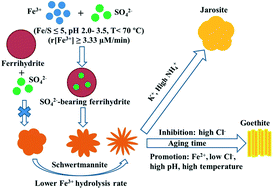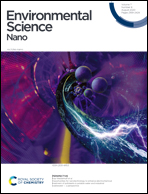Formation and transformation of schwertmannite through direct Fe3+ hydrolysis under various geochemical conditions†
Abstract
Schwertmannite formation and transformation, key processes that influence the speciation, mobility, and environmental fate of associated trace elements in acid mine drainage (AMD), were primarily studied through Fe2+ oxidation–hydrolysis. Direct Fe3+ hydrolysis is another important schwertmannite formation pathway, but the effects of geochemical conditions on the mineralogical properties of schwertmannite formed via such a pathway are poorly known. Here, the formation of schwertmannite through direct Fe3+ hydrolysis enforced by heating or adding OH− and subsequent transformation were systematically examined under various geochemical conditions. Pure schwertmannite is obtained through Fe3+ hydrolysis at 25–60 °C for 12 min and subsequent dialysis for 1–15 days, while minor amounts of goethite appear at higher hydrolysis temperatures. A shorter dialysis time and the presence of K+ or NH4+ both slightly increase schwertmannite crystallinity. During Fe3+ hydrolysis by adding OH−, sulfate-bearing ferrihydrite initially forms and then quickly transforms into schwertmannite. In contrast, pre-formed ferrihydrite does not transform into schwertmannite under the same solution conditions, despite sulfate adsorption. With decreasing Fe3+ hydrolysis rate, schwertmannite crystallinity slightly increases and its morphology of “network” structure becomes larger and less dense. As to schwertmannite transformation, high temperature, high pH, and the presence of Fe2+ favor its transformation to goethite, while a low Fe3+ hydrolysis rate and a high Cl− concentration hinder the transformation. In contrast, the presence of K+ or high NH4+ concentration favors schwertmannite transformation to jarosite with the former occurring more readily. These new insights into schwertmannite formation and transformation are essential for predicting the environmental fates of associated trace elements in AMD environments.

- This article is part of the themed collection: Environmental fate of nanomaterials


 Please wait while we load your content...
Please wait while we load your content...